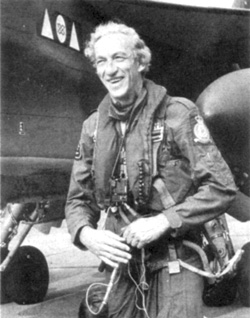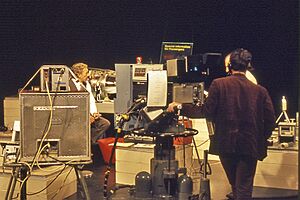Raymond Baxter facts for kids
Quick facts for kids
Raymond Baxter
|
|
|---|---|

Baxter with a Jaguar aircraft in 1976
|
|
| Born |
Raymond Frederic Baxter
25 January 1922 |
| Died | 15 September 2006 (aged 84) Reading, Berkshire, England
|
| Nationality | British |
| Occupation | television presenter Commentator writer |
| Employer | BBC Television (1950–2006) |
| Known for | Tomorrow's World |
Raymond Frederic Baxter (born January 25, 1922 – died September 15, 2006) was a famous English television presenter, commentator, and writer. He is best known for being the very first host of the BBC Television science show Tomorrow's World. He presented the show for 12 years, from 1965 to 1977. Raymond also provided radio commentary for many important events, including the coronation of Queen Elizabeth II and the first flight of the Concorde airplane.
Contents
Early Life and School
Raymond Baxter was born in Ilford, a town in Essex, England. His father was a science teacher. Raymond went to Ilford County High School, which was a school for boys. He left school early and did not go to college or university. For a short time, he worked at the Metropolitan Water Board in London.
Flying for the Royal Air Force
Joining the RAF
In August 1940, during World War II, Raymond joined the Royal Air Force (RAF). He trained to become a fighter pilot in Canada. His first planes were Supermarine Spitfires, which he flew with a squadron based in Scotland.
Wartime Missions
In 1943, Raymond joined another squadron and flew over Sicily. He was recognized for his brave actions during this time. In 1944, he returned to England to become an instructor. He later went back to active flying duty in September 1944.
On March 18, 1945, Raymond took part in a daytime raid on a building in The Hague. This building was a German headquarters for V-1 and V-2 rocket attacks on southern England. Raymond and three other pilots were again recognized for their bravery.
Raymond once shared a story about flying over a V-2 rocket launch site in 1945. His wingman even fired at the missile! Raymond joked, "I dread to think what would have happened if he'd hit the thing!"
After the War
After the war, Raymond flew other types of planes for a year. From 1945 to 1949, he worked for the British Forces Broadcasting Service (FBS) in Cairo and Hamburg. He became the deputy director there. He left the RAF in 1946 as a flight lieutenant.
Raymond's BBC Career
Starting at the BBC
Raymond Baxter joined the BBC in 1950. He became known for his clear and strong voice. He provided radio commentary for important events like the funerals of King George VI in 1952 and Winston Churchill in 1965. For the King's funeral, he even gave his commentary while hanging from the ceiling of Westminster Abbey! He also reported from Trafalgar Square during the coronation of Queen Elizabeth II in 1953.
A Love for Cars and Planes
Raymond was a skilled rally car driver. He competed in the famous Monte Carlo Rally twelve times. He also took part in many other rallies. He was even a crew member in a big air race from London to New Zealand in 1953.
Because of his clear voice, Raymond often commentated on events involving cars and planes. He was the BBC's motoring correspondent from 1950 to 1966. He covered many Formula One races, the Le Mans 24-hour race, and the Monte Carlo Rally. He also presented the BBC's coverage of the Farnborough Airshows for many years.
Raymond reported on the first flight of the Concorde supersonic jet. He was also the first reporter to broadcast live from an airplane, an ocean liner, and even from underwater! For three decades, he was the regular commentator for the annual Royal British Legion's Festival of Remembrance at the Albert Hall.
Tomorrow's World
From 1959 to 1963, Raymond presented a science series called Eye on Research. Then, in July 1965, he became the first host of the very popular science show Tomorrow's World. The show explored new inventions and scientific discoveries. It was watched by up to 10 million people!
Raymond was part of many broadcasting firsts. In 1962, he presented the first live TV broadcast from the US to the UK using the Telstar satellite. In 1966, he did the first live TV broadcast from Australia. In 1967, he interviewed the South African surgeon Christiaan Barnard by phone, just hours after the world's first heart transplant operation.
Raymond left Tomorrow's World in 1977. He was later honored with the first Raymond Baxter Award for Science Communication in 2000. He was surprised to find out he was the first person to receive it!
Other Activities and Honors
Raymond Baxter also narrated films about the Hammond Organ and the history of Rolls-Royce cars. He also presented films about fire safety in hospitals.
In 1978, Raymond was made an Honorary Freeman of the City of London. This is a special honor given to people who have made a great contribution to the city. In 2003, he was awarded the OBE for his work.
He was also involved with the Royal National Lifeboat Institution (RNLI) for many years, helping with their important work saving lives at sea. He was also a founder of the Association of Dunkirk Little Ships. He even owned one of the small boats that helped rescue British troops from the beaches of Dunkirk during World War II.
In 1998, Raymond was the subject of the TV show This Is Your Life, where famous people are surprised by their friends and family.
Personal Life
Raymond married his American wife, Sylvia Kathryn Johnson, in 1945. They had a son named Graham and a daughter named Jenny. Jenny became a fencing coach. Sylvia passed away in 1996. Raymond Baxter died on September 15, 2006, at the age of 84, in Reading, England. His family said he had "a love of innovation and challenge both professionally and personally."
Film Appearances
Raymond Baxter appeared as himself in a few films:
- Mask of Dust (1955)
- The Fast Lady (1962)
- Grand Prix (1966) – as a BBC interviewer


